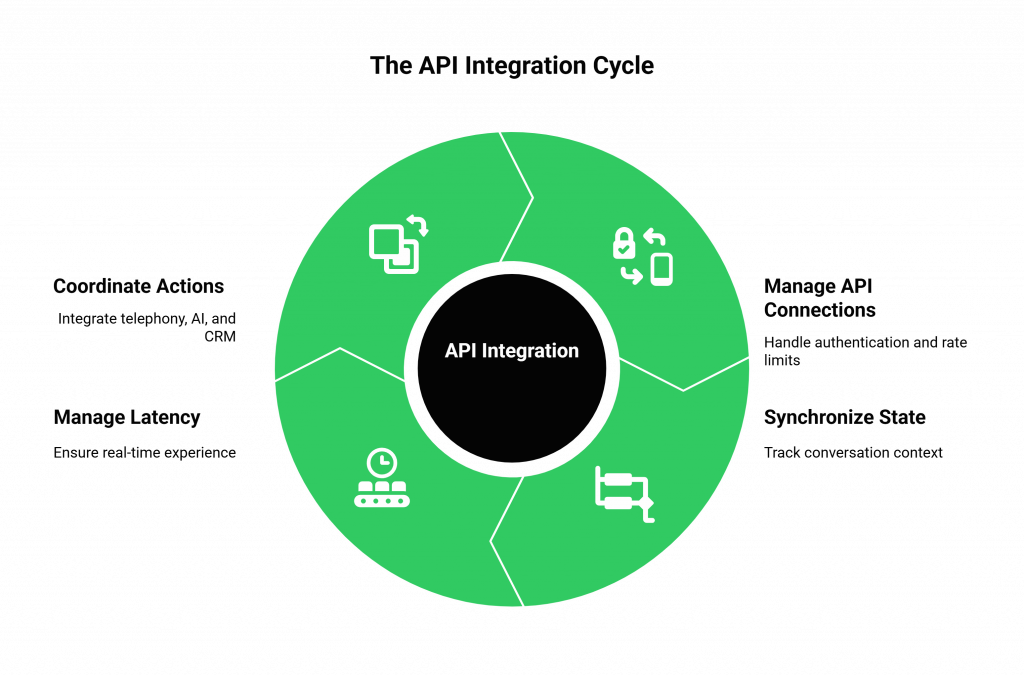The promise of the open API economy has reached the Contact Center. The vision is compelling: build a sophisticated, AI-powered voicebot by assembling a best-in-class solution from a universe of specialized APIs. You can handpick the most accurate Speech-to-Text engine, the most intelligent Large Language Model, and the most lifelike Text-to-Speech service, creating a voicebot that is perfectly tailored to your business needs. This flexible, extensible approach promises to revolutionize customer service by automating interactions and freeing human agents to focus on high-value tasks.
Table of contents
- What is a Voicebot Contact Center with Open APIs?
- The Integration Chaos: The Hidden Challenge of Open APIs
- FreJun: The API-First Orchestration Layer for Your Contact Center
- The Standard Multi-API Approach vs. The FreJun API-First Approach
- A Step-by-Step Guide to a Modern Voicebot Contact Center
- Best Practices for a Flawless Integration
- Final Thoughts: From API Chaos to Intelligent Orchestration
- Frequently Asked Questions (FAQ)
However, many organizations that embark on this journey find themselves in a technical quagmire. The very openness that offers so much promise also introduces a significant challenge: integration chaos. Orchestrating a dozen different APIs in a real-time, high-stakes environment like a Contact Center is a monumental engineering task, one that can quickly derail projects and negate the expected benefits.
What is a Voicebot Contact Center with Open APIs?
A Voicebot Contact Center built with open APIs is a system that integrates conversational AI into its core telephony operations. It’s a move away from monolithic, black-box solutions toward a more flexible, modular architecture. The key components, all connected via APIs, include:
- The Contact Center Platform: The core system that manages calls, agent queues, and CRM data.
- The Voicebot Orchestration Layer: The middleware that connects the telephony system to the AI services.
- Speech-to-Text (ASR) API: Transcribes the caller’s spoken words into text.
- Language Understanding (LLM/NLU) API: The AI “brain” that deciphers intent and formulates a response.
- Text-to-Speech (TTS) API: Synthesizes the AI’s text response back into a natural, audible voice.
This API-driven approach allows for the creation of custom workflows, seamless handoffs between the bot and human agents, and deep integration with business-critical systems.
The Integration Chaos: The Hidden Challenge of Open APIs

While the modular architecture is powerful in theory, the practical reality of making it work is incredibly complex. When you try to connect your telephony provider (like Twilio or Vonage) directly to your AI stack (like OpenAI and ElevenLabs) and your CRM, you are responsible for building and maintaining the entire orchestration layer yourself. This means solving a host of difficult problems:
- Managing Multiple API Connections: You have to handle authentication, rate limiting, and error handling for numerous different services, each with its own specifications.
- Synchronizing State: You must build a complex state machine to track the conversation’s context, especially when handing off a call from the bot to a human agent.
- Latency Management: Each API call in the chain adds latency. Orchestrating them in a way that provides a sub-second, real-time conversational experience is a major challenge.
- Lack of a Unified Control Plane: There is no single point of control. Transferring a call, for example, requires coordinating actions between your telephony API, your bot logic, and your CRM, a brittle and error-prone process.
This is the integration chaos. Your team, expert in AI and customer experience, is suddenly forced to become an expert in real-time, distributed systems engineering.
FreJun: The API-First Orchestration Layer for Your Contact Center
This is the exact problem FreJun was built to solve. We are not another AI or telephony API to add to the pile. FreJun is the specialized voice infrastructure platform that provides the orchestration layer as a simple, powerful, and open API. We act as the intelligent bridge that connects your AI “brain” to your existing Contact Center infrastructure.
FreJun allows you to reap the benefits of an open API approach without the integration headache.
- We are AI-Agnostic: You bring your own voicebot. Whether it’s built on GPT-4, Rasa, or a proprietary NLU, our platform can connect to it.
- We Integrate with Your Existing Systems: We provide the flexible middleware that can seamlessly forward calls and pass rich data to your existing agent queues.
- We Provide a Simple, Unified API: We handle all the complexities of real-time audio streaming and call control. Your developers can focus on building high-level business logic, not on debugging low-level API connections.
With FreJun, you can build a flexible, scalable, and intelligent voicebot for your Contact Center in a fraction of the time, and with a fraction of the complexity.
The Standard Multi-API Approach vs. The FreJun API-First Approach
| Feature | The Standard Multi-API Approach (DIY Orchestration) | The FreJun API-First Approach (Managed Orchestration) |
| Integration Complexity | High. You must manually connect and manage multiple disparate APIs. | Low. You connect your AI to a single, unified voice infrastructure API. |
| Flexibility | High, but comes with a massive development and maintenance burden. | High. You maintain full control over your AI and business logic. |
| Agent Handoff | Difficult. Requires custom solutions to pass context. | Easy. Full conversation context is passed to the agent via a simple API call. |
| Developer Focus | Wrestling with low-level API connections and state management. | Building intelligent conversational logic and business workflows. |
| Time to Deployment | Months. Requires deep, specialized engineering expertise. | Days or weeks. Built for modern, agile development teams. |
| Scalability & Reliability | Your responsibility to build and maintain a resilient, scalable system. | Built on a globally distributed, enterprise-grade cloud platform. |
A Step-by-Step Guide to a Modern Voicebot Contact Center
This guide outlines the modern, FreJun-powered approach to integrating your voicebot with your Contact Center.

Step 1: Build Your Voicebot’s “Brain”
First, build your core AI logic. Use your preferred open APIs to create the conversational pipeline: an ASR service to transcribe, an LLM to process intent, and a TTS service to synthesize responses. This “brain” will live in your backend.
Step 2: Route Your Inbound Calls Through FreJun
Instead of sending calls directly to your existing Contact Center IVR, you port your main support number to FreJun or forward calls to a FreJun-provisioned number. This makes FreJun the new, intelligent front door for all your voice interactions.
Step 3: Connect FreJun to Your Voicebot
In the FreJun dashboard, you configure your number’s webhook to point to your voicebot’s backend API endpoint. When a call comes in, FreJun establishes a real-time, bi-directional audio stream with your bot, allowing the conversation to begin.
Step 4: Implement the Bot-to-Human Handoff Logic
This is the most critical part of the workflow. When your bot’s logic determines that a human agent is needed, your backend makes a simple API call to FreJun with two key pieces of information:
- The phone number or queue extension of the human agent/department in your existing Contact Center.
- A payload of data containing the full context of the conversation (e.g., customer ID, issue type, and a transcript of the bot interaction).
Step 5: FreJun Manages the Transfer and Context Pass
FreJun seamlessly transfers the live call to the specified agent. Simultaneously, our platform can make a separate API call to your CRM or helpdesk software to post the conversation context, so the agent’s screen is populated with all the relevant information before they even answer the call.
Key Takeaway
Building a Contact Center voicebot with open APIs is a two-part challenge. The first is building the AI “brain,” where the flexibility of open APIs is a huge advantage. The second, much harder part is building the orchestration layer to connect that brain to your telephony infrastructure. FreJun provides this second part as a simple, powerful, and open API, allowing you to get the best of both worlds: full control over your AI and a hassle-free, enterprise-grade integration.
Best Practices for a Flawless Integration
- Prioritize a Seamless Handoff: The key to a successful bot-to-human transfer is context. Ensure all relevant information is passed to the agent to avoid forcing the customer to repeat themselves.
- Use Persistent Connections: For real-time, low-latency conversations, leverage a platform like FreJun that uses WebSockets for streaming audio and events.
- Secure All API Endpoints: Use OAuth, API keys, and TLS encryption to protect all communication between your services and ensure compliance with privacy regulations.
- Continuously Monitor and Refine: Use the analytics from your AI, your Contact Center, and your infrastructure provider to get a complete picture of your workflow. Use these insights to continuously improve your bot’s accuracy and the overall customer experience.
Final Thoughts: From API Chaos to Intelligent Orchestration
The open API ecosystem offers an incredible opportunity to build a custom, best-in-class voicebot for your Contact Center. But this freedom and flexibility can quickly lead to a nightmare of integration chaos if you don’t have the right architectural foundation.
The strategic path forward is not to abandon the power of open APIs but to embrace a specialized orchestration layer that tames their complexity. By leveraging a platform like FreJun, you can focus on what you do best, building a brilliant AI and designing a great customer experience, while we handle the complex, undifferentiated heavy lifting of voice infrastructure.
You can finally move beyond the challenge of just making things work and start building a truly intelligent, automated, and efficient Contact Center for the future.
Further Reading – Stream Voice to a Chatbot Speech Recognition Engine via API
Frequently Asked Questions (FAQ)
No, it integrates with them. FreJun acts as the intelligent front door and the middleware. We receive the call, let your voicebot handle the initial interaction, and then seamlessly transfer the call and the context to your existing agent queues and CRM.
Yes. FreJun is completely AI-agnostic. As long as your model can be accessed via an API, our platform can connect to it.
While CPaaS providers give you the raw telephony “pipes,” you are still responsible for building the entire orchestration layer that connects those pipes to your AI stack and your Contact Center. FreJun is that orchestration layer, provided as a simple, unified API, which dramatically accelerates your time to market.
When your backend instructs FreJun to transfer a call, you can include a payload of data. Our platform can then make a separate API call to your CRM or helpdesk software to post this data, so it appears on the agent’s screen when they receive the call.
Absolutely. You can use FreJun’s API to initiate outbound calls with your voicebot for use cases like appointment reminders or feedback surveys, with the option to connect the customer to a live agent at any point during the conversation.
